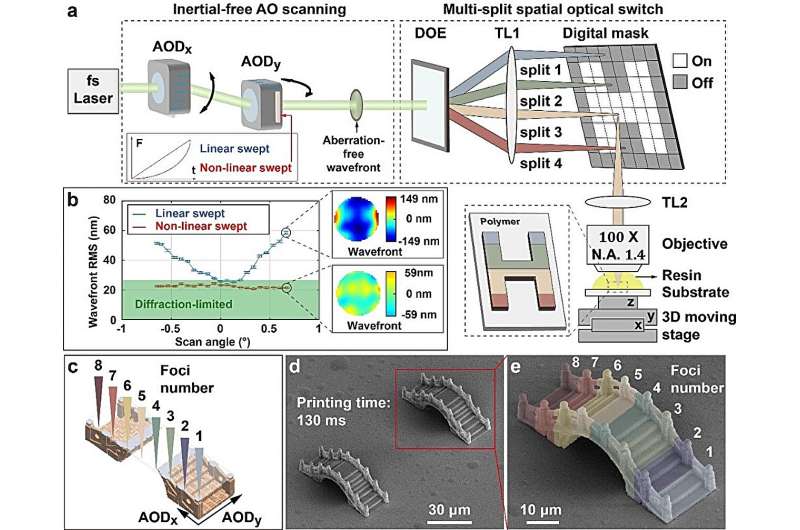Professor Wei Xiong’s group, from the Wuhan National Laboratory for Optoelectronics at Huazhong University of Science and Technology, proposes a pioneering high-speed multi-photon polymerization lithography technique with a record-high 3D printing rate of 7.6 × 107 voxel s−1, which is nearly one order of magnitude higher than earlier scanning multiphoton lithography (MPL).
Published in International Journal of Extreme Manufacturing (IJEM), this technology, based on acousto-optic scanning with spatial-switching (AOSS), not only prints complex 3D micro-nano structures with an accuracy of 212 nm, but also achieves an unprecedented 3D printing rate of 7.6 × 107 voxel/s. It’s like an artist painting a self-portrait in merely five minutes, where every intricate detail, down to each strand of hair, comes vividly to life.
“Processing speed and processing accuracy are important performance parameters for evaluating micro-nano three-dimensional printing technology, and this technology has excellent performance in both aspects,” said Prof. Wei Xiong. “This research provides a feasible technical route for achieving large-scale nano-3D printing in the future.”
The precision manufacturing of intricate and complex three-dimensional micro-nano structures serves as a foundational cornerstone for numerous forefront disciplines. In light of its inherent capacity for true three-dimensional digital fabrication and nanoscale processing resolution beyond the diffraction limit, two-photon lithography(TPL) has consistently remained a focal point of research within the field.
It has now found extensive applications in cutting-edge domains including three-dimensional metamaterial, micro-optical, microelectronic components, and biomedical engineering.
However, despite its high nanoscale resolution capabilities, the limited processing speed of TPL has persistently constrained its potential. For example, the printing of a simple coin can often extend over dozens of hours, a timeframe clearly inadequate for industrial production applications.
Then Jiao began a series of experimental studies and eventually found the acousto-optic deflector (AOD) as the centerpiece of the process to increase printing speed.
Traditional scanning-based TPL employs mechanical scanning methods like galvanometric mirrors, but their scanning speed is constrained by inertia. In contrast, the acousto-optic deflector (AOD) can achieve inertial-free acousto-optic scanning, resulting in a significant advancement in the speed.
“The motion of a moving car usually includes sequential actions such as braking, turning around, and subsequent acceleration which inherently consumes a substantial amount of time due to the influence of inertia,” said Binzhang Jiao (Ph.D. 22), the first author of the paper.
A galvanometer with inertia is just like a car, where acceleration and deceleration processes are time-consuming. On the other hand, AOD is not constrained by inertia, because it relies on sound waves for scanning. Compared to traditional mechanical mirror scanning, this approach has yielded a 5 to 20-fold increase in laser scanning speed.
Jiao has successfully developed a nonlinear signal modulation technique of the AOD, ensuring the spot size approximates the diffraction limit during high-speed acousto-optic scanning. Concurrently, the integration of diffractive optical elements (DOE) has enabled multi-focal parallel acousto-optic scanning, further enhancing processing throughput. The spatial regions of the multi-focal spots are independently controlled by the spatial optical switch, enabling the fabrication of non-periodic structures.
They demonstrated an eight-focal-point Multiphoton Lithography (MPL) system, achieving voxel size of 212 nm and the voxel printing rate of 7.6 × 107 voxel/s.
“Multiple focal points can be printed separately, as if one person had eight hands,” said Jiao. This voxel printing rate is 8.4 times faster than the fastest mechanically scanned MPL method reported in the past, and 38 times faster than the fastest diffractive scanned MPL method reported. When compared to commercialized MPL methods, the printing speed of this technique can be enhanced by up to 490 times.
Although it is still a long way to go from labs to factory, the team expresses optimism about the future of AOSS. “To increase acousto-optic scanning range, the scanning angle of the acousto-optic scanning can be increased in the future. Accordingly, a higher acousto-optic scanning speed and an increased number of foci can continue to increase the throughput of AOSS,” said Prof. Wei Xiong.
Subscribe to AM Chronicle Newsletter to stay connected: https://bit.ly/3fBZ1mP
Follow us on LinkedIn: https://bit.ly/3IjhrFq
Visit for more interesting content on additive manufacturing: https://amchronicle.com


